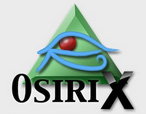3D Slicer
 | |
| Original author(s) | David Gering[1] |
|---|---|
| Developer(s) | Steve Pieper[1] and the 3DSlicer community |
| Initial release | 2000 (1.2.?)[2] |
| Stable release |
5.0.1 (May 1, 2022) [±] |
| Preview release | none [±] |
| Written in | C, C++[1] |
| Operating system | Linux, MacOS X, Windows |
| Type | Imaging informatics software |
| License(s) | BDS-style |
| Website | https://www.slicer.org/ |
3D Slicer is free open-source extensible image processing software for the analysis and visualization of medical images. The software is not restricted in its user, though the developers note that it's not approved by the FDA for clinical use.[3]
Product history
3D Slicer was first conceived by David Gering, an MIT graduate student, as part of a master's thesis project in 1998 and 1999.[4] Teaming up with the Surgical Planning Laboratory at the Brigham and Women's Hospital, Gering and the MIT Artificial Intelligence Laboratory developed 3D Slicer as a "community-based platform created for the purpose of subject-specific image analysis and visualization."[1] The two entities continued work on the software, which as early as 2000 was made open-source and freely available via an FTP server.[2] By early 2007, the download and contribution process modernized to allow direct download and access to repositories without initial registration.[5]
Features
3D Slicer has features including:
- support for DICOM and other image formats
- non-linear transforms
- visualization of transforms in 2D and 3D
- registration and interactive segmentation of image/data
- analysis and visualization of diffusion tensor imaging data
- output of a filtered transform node based on tracker input
- support for command-line interface (CLI) modules
- extensible with numerous supported extensions
For more, see the 4.5 announcement page.
Hardware/software requirements
The system requirements for 3D Slicer include[6]:
- Windows 7 64bit, MacOS X Lion (or Maverick, w/ update), or recent Linux distro
- 8GB of memory
- 1280x1024 monitor resolution
- dedicated graphics with at least 1GB or memory
- multi-core or multi-CPU setup useful
Videos, screenshots, and other media
Entities using 3D Slicer
Further reading
External links
References
- ↑ 1.0 1.1 1.2 1.3 Jolesz, F.A. (2014). "History of Image-Guided Therapy at Brigham and Women's Hospital". In Jolesz, F.A.. Intraoperative Imaging and Image-Guided Therapy. Springer Science & Business Media. pp. 25–45. ISBN 9781461476573. https://books.google.com/books?id=-Ue9BAAAQBAJ&pg=PA25. Retrieved 25 August 2016.
- ↑ 2.0 2.1 "3D Slicer - Get the Software". MIT. Archived from the original on 18 October 2000. https://web.archive.org/web/20001018170648/http://scooby.ai.mit.edu/. Retrieved 25 August 2016.
- ↑ "SlicerWiki". Surgical Planning Laboratory. http://wiki.slicer.org/slicerWiki/index.php/Main_Page. Retrieved 25 August 2016.
- ↑ Gering, D.T. (December 1999). "A System for Surgical Planning and Guidance using Image Fusion and Interventional MR". Massachusetts Institute of Technology. http://www.spl.harvard.edu/publications/item/view/1040. Retrieved 25 August 2016.
- ↑ "3D Slicer". Surgical Planning Laboratory. Archived from the original on 28 April 2007. https://web.archive.org/web/20070428093255/http://www.slicer.org/. Retrieved 25 August 2016.
- ↑ "Documentation/Nightly/SlicerApplication/HardwareConfiguration". Surgical Planning Laboratory. https://www.slicer.org/slicerWiki/index.php/Documentation/Nightly/SlicerApplication/HardwareConfiguration. Retrieved 25 August 2016.









